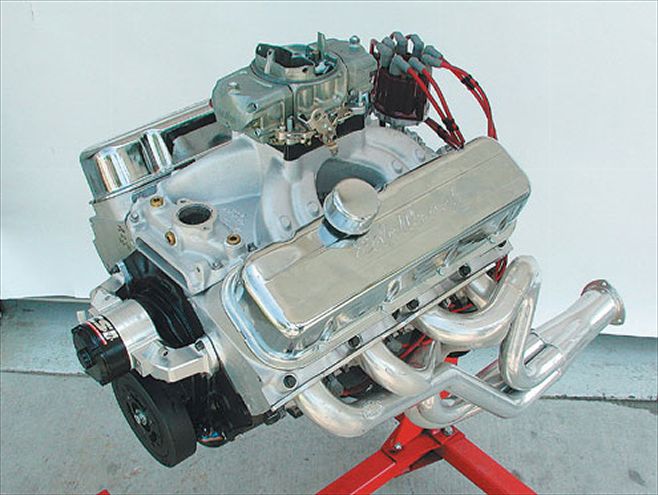

Chevy's 454 engine sets the standard for all other big-blocks. Most fat-block development centers around the popular Rat motor; cams, heads, and intake designs are developed for it first, then "adapted" to other makes. We wondered how well a Rat would run if it were built like our recent 455 GM and 460 Ford buildups using a Comp Xtreme Energy hydraulic cam, 10:1 compression, and Edelbrock aluminum heads. In theory, it should come out on top. Did it? Read on and see.
Induction, Exhaust, Ignition
What better intake to use with Edelbrock heads than those from "Big E"? We evaluated both a Victor Jr. and an Air-Gap RPM. MSD's Pro Billet breakerless distributor was fired by Westech's standard dyno rig: an MSD HVC high-output coil and Digital 7 ignition. Hooker Super Competition headers for a '67-'69 Camaro (2x33-inch primaries into 31/2x10-inch collectors) and 31/2-inch inlet DynoMax Race Magnums exhausted the spent mixture on the dyno.
Cylinder Heads
There's no shortage of aftermarket heads for Chevy's Rat motor, the world's most popular big-block. If anything, it's easy to go off the deep end and wind up with heads that are way too big for daily street use. One of the best all-around compromises is Edelbrock's Performer RPM 454-O castings, which combine the flow of factory rectangular-port heads with the velocity of the standard oval-port configuration. Unlike factory castings, the Edelbrock head's deck surface and water jacket is compatible with both early and late Chevy engine blocks.
Lubrication
Big-block Chevy oiling systems are virtually bulletproof--just use reasonable bearing clearances, add a good oil pump such as Speed-Pro's Marine high-volume unit, and properly position the pump pickup close to the sump floor. This engine even scraped by with a factory Chevelle five-quart (with filter) oil pan.
Cam and Valvetrain
Comp's Xtreme Energy cam is more aggressive than other cams with similar 0.050-inch durations, yet it still makes decent idle vacuum. We went with the XE274H flat-tappet hydraulic cam--the same basic grind used on the other big-blocks in this ongoing series. This is a fairly mild cam for the Rat motor's free-flowing heads, but we wanted to be fair to the Chevy's other big-block competitors.
Rat motors use different intake and exhaust pushrods. With the milled block, Edelbrock heads, and Fel-Pro head gasket, nonstock lengths were needed to maintain proper valvetrain geometry--0.175-inch shorter on the intake side; 0.200-inch shorter on the exhausts.
Camshaft Specifications Manufacturer: Comp Cams Part No.: 11-246-3 Grind: CB XE274H-10 Type: Hydraulic flat-tappet Duration at 0.006-inch tappet lift: 274* int./286* exh. Duration at 0.050-inch tappet lift: 230* int./236* exh. Valve lift (1.70:1 rockers): 0.552" int./0.555" exh. Lobe displacement angle (LDA): 110* Installed intake centerline: 107*Test Results
The engine was tested on Westech's SuperFlow dyno using the same size 750-cfm Speed Demon carb as the other big-block buildups in this series, achieving its best peak power number of 542.3 hp at 5,600 rpm with a single-plane Victor Jr. 454-O intake and a 1-inch spacer. Edelbrock's RPM Air-Gap 2-O dual-plane and a 1-inch spacer made 13 more lb-ft of torque at the peak (565.1 lb-ft compared to 552.1 lb-ft), but at the cost of 9.1 hp on the top-end. However, in terms of overall average output, the Air-Gap also topped the Victor Jr. by 8.8 lb-ft and 6.3 hp. By way of comparison, the peak torque and power output of the similarly configured, Rat-like Ford 460 featured in the May '01 issue were within five numbers of the 454's dual-plane configuration. With over 579 lb-ft, the long-stroke Pontiac (Jan. '01) remains the current torque champ, but the Buick 455 and Mopar 440 are still to come.
Rotating Assembly
Dougan's decked the block, bored and honed the cylinders with a torque plate, turned the crank, align-honed the block, rebuilt the rods, and hung the pistons. We wanted about 10:1 compression with the aluminum heads for compatibility with pump gas. Getting there with off-the-shelf forged pistons and the Edelbrock heads required severely milling the block. The pistons ended up 0.005 inch above the deck at TDC, leaving only 0.034-inch piston-to-head clearance with the Fel-Pro 0.039-inch compressed thickness head gasket. This also creates good quench for max power without increasing the detonation threshold, but the tight clearance can pose problems in a higher revving engine. We usually like to see 0.035-0.040 inch on 7,000-plus-rpm mills running steel rods.
The well-used block required a 0.060-inch overbore before it would clean up; fortunately, premium Speed-Pro file-fit, plasma-moly rings are widely available in most overbores and ring-thickness variations for the popular Chevy big-block. The same goes for Federal Mogul's rugged H-14 Competition Series alloy, 3/4-groove main bearings and large-chamfer rod bearings, both of which are available standard; 0.001-inch oversize; and 0.001-, 0.009-, 0.0010-, 0.0011-, 0.0019-, 0.002-, 0.0021-, and 0.003-inch undersize. This allows the precision assembler using a standard, 0.010-, or 0.020-under crank to fine-tune bearing clearances within 0.0015 inch by mixing and matching shells from different sets. Westech went with straight 0.010-under bearings here to mimic what the average Joe Streeter would do.